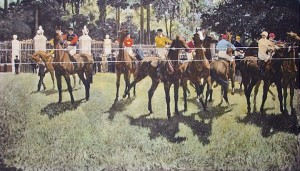Do you toe the line …
… or tow the line?
Are towing and toeing both correct, when it comes to the line? Glosso’s X v Y series takes a look …
Stephen Holden, reviewing the movie Thanks for Sharing in Thursday’s New York Times, went for the tow-line — hook, line and sinker. According to the writer, one of the movie’s characters, Mike, is “married and towing a straight and narrow line.”
And he’s in good company (Holden, that is, not Mike — although he might well be too): a Google search of the words “tow the line” yields over a million results. It’s what some people might call an ‘eggcorn’ (see a previous Glossophilia post on this topic), because the word “tow-line” is more familiar to us in modern usage than any line involving the digits at the end of our feet, and so the misspelling is common. And I have to admit that this is how I spelled the phrase until yesterday, when a friend pointed out the movie review blooper (which might well have been fixed by the time this post is published) and thankfully enlightened me.
To “toe the line” is an expression that means to conform to a standard or rule. Nowadays it’s often used in a political context: “toeing the party line”means behaving according to the rules prescribed by a political or other factional persuasion. It’s also used in sports to describe athletes poised at the starting line of a race or boxers “toeing the center line” before the start of a match. (And John Byam Shaw’s painting “Toeing the Line (Ascot)” depicts lines at the start of the famous horse-race.)
But sports and racing aren’t necessarily at the root of the phrase’s etymology. According to the Oxford Dictionary of Word Histories, “toe the line” wasn’t adopted into athletic contexts until the early 19th century, but it was in use with its figurative sense long before that. Its true origin is not definitively known, although there are several plausible theories all involving institutions known for their squabbling and for their disciplinary traditions: the British parliament, schools, and the armed forces.
The House of Commons is the lower house of the British parliament. Two red lines are painted on the floor between the two front benches on which leaders of the opposing political parties sit — and the lines are roughly two sword-lengths apart. Traditionally, debating MPs — or those giving speeches — are not allowed to step beyond the line on their own side of the floor; it’s argued that this rule was introduced to prevent any potential sword-fights between squabbling political opponents. And so the expression ‘toe the line’ was born — at least according to Houses of Parliament tour guides and guidebooks. However, there’s no evidence that Members of Parliament were ever allowed to bring swords into the house, and so, sadly, this colorful theory has been discounted.
A more likely origin of the expression dates back to the early 18th century, when sailors in the British Royal Navy lined up for inspection on the wooden decks of ships, with their bare feet lining up along the plank-lines — hence giving rise to the command to “toe the line”. The sailors were also expected to “toe the line” for long periods of time as punishment, however inclement the weather might have been on the high seas. Military parade-grounds sometimes have white lines on which soldiers are expected to fall in, and army barracks (especially in the U.S.) have yellow lines on red linoleum floors on which soldiers are ordered to cease all activity and “toe the line!”. Roll-calls at many traditional schools call for students to stand with their toes aligned on the floor.
There were other similar expressions in the 19th century — “toe the mark”, “toe the scratch”, “toe the crack”, “toe the plank”, or “toe the trig” — all of which referred in some way to men lining up for parade, discipline or competition readiness, and all with lines drawn, improvised or circumstantial across which no-one was to step. In the sporting world, scratch has been used since the 18th century for a starting line scratched on the ground; trig is also an old sports term for a boundary or center line.
These alternative forms of the idiom eventually faded from use, with “toe the line” being the sole modern survivor, but they did all tend to assume metaphorical as well as literal meanings in their time; the earliest known use of the expression in print in its figurative sense (ie. of conforming to a standard or rule) is admittedly in one of these alternative forms. In The Diverting History of John Bull and Brother Jonathan by Hector Bull-Us (a pen-name for James Paulding), published in 1813, the sense of “behaving suitably” was clearly apparent: “He began to think it was high time to toe the mark.”
(Hat-tip to Judith.)
First posted Sep 2013.



